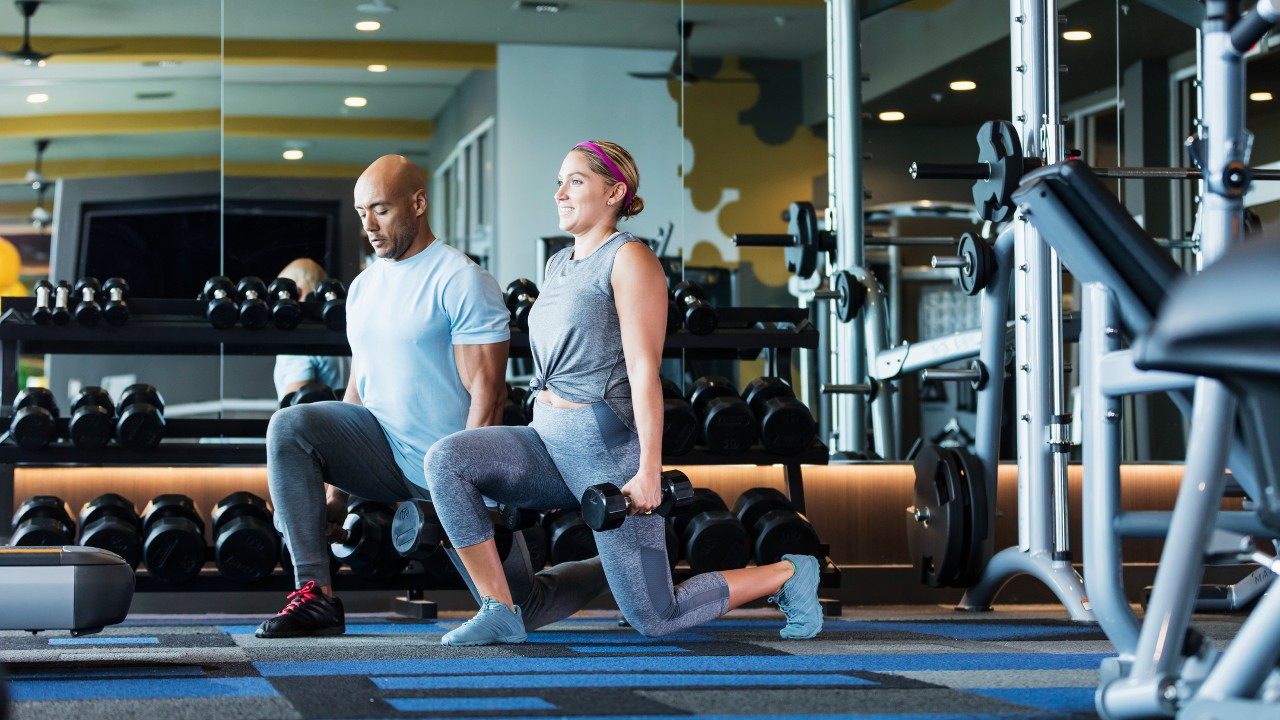Learn How To Do A Lunge With Perfect Form Using This Step-By-Step Guide For Beginners
Enjoy enhanced lower-body strength, stability and sporting prowess by mastering the form for the lunge exercise

If you play sports, there are few bodyweight exercises so worthwhile as the lunge. By simply taking a stride forward and dropping your back knee to the floor, you target multiple joints and muscle groups, making them stronger and improving your balance and flexibility overall.
Sounds easy, right? In reality, it requires co-ordination, control and practice to do it properly. To master this essential exercise, and understand how it could help you, we spoke to running specialist Rory Knight, director of fitness at leading fitness app WithU. Here’s his expert guide, tips on how to avoid the move’s common pitfalls and an explanation of why it’s totally safe to let your knees travel beyond your toes.
And once you can lunge with the best of them, keep scrolling to find a range of lunge variations to help you progress.
How To Do A Lunge
The Set-up
Stand tall with your feet hip-width apart and your core engaged but not overly tense. Identify a point on the floor a meter or so in front of you where you will aim to land with each step forward. Keep your chin up to correct your posture so you don’t end up staring down at your leading foot, which makes balancing more difficult.
The Descent
Take a generous step forward, landing with your weight evenly distributed across your heel and midfoot, and your torso upright, rather than with your bodyweight over your front leg. Your back heel will lift off the floor at this point. Bend both knees to lower until your back knee is just off the floor—or you can tap it gently on the floor. Keep your front knee directly above your front foot.
“Always control the descent, even as you fatigue,” says Knight. “Use your glutes and hamstrings to slow the eccentric phase of the move. Feel the rep, don’t steal the rep.”
The Return
To return to the start, powerfully press through the heel and midfoot of your front foot and step back to standing. When driving out of the deep lunge position, keep your core engaged and torso upright, rather than leaning over your front knee. Reset, then repeat on the same side, or alternate sides with each rep.
Sign up for workout ideas, training advice, reviews of the latest gear and more.
“Once you feel strong and stable and can confidently perform eight to 12 reps on each side, don’t be afraid to add load so that you can progress this exercise further,” says Knight.
Common Lunge Mistakes
Crowding Your Front Leg
A strong, safe forward lunge relies on accurate foot placement. Too big a step forward and any impingements in mobility will limit the depth you can sink per rep. Too small a step and you’ll crowd out your front leg, tipping your bodyweight forward and overloading your knee and ankle. Before you add any extra load, practice a few reps to locate the sweet spot, then mark it out like a cricketer measuring their bowling run-up.
Failing To Control The Descent
Another common lunge faux pas, says Knight, is smashing your back knee into the floor every rep. “Lowering your knee to gently touch the floor ensures you’re performing the exercise with a good range of motion, but if it’s hurtling into the ground I can guarantee you will not be engaging your muscles optimally,” he says. “Control the descent and slow down the eccentric element of the exercise.”
Losing Your Balance
A slight wobble here and there is inevitable with any lunge variation, but if you’re pressing from an unstable base you won’t be able to complete many reps or add load safely. A simple fix is to focus on the connection between the floor and your front foot.
“Your feet are the connection point between you and the ground,” says Knight. “To enhance that connectivity and become more stable in your lunge, think of your foot as a tripod gripping the floor at three points—your big toe, your little toe and your heel. Try it. I can guarantee you’ll feel greater engagement, more connectivity and, ultimately, much stronger all over.”
Should you let your knees travel past your toes when lunging?
A common phrase you’ll hear from PTs coaching the lunge is to “keep your knees over your toes”. This means that to protect the integrity of your knee and ankle joints, you should keep your knee tracking in the same direction as the toes on the same foot, rather than allowing the knee to buckle inwards.
A misconception related to this phrase, however, is that you should never let your front knee travel beyond your toes at the bottom of a lunge. As Knight says, as long as you can control the alignment between your hip, knee and ankle, and you don’t feel any pain or discomfort, then it is “totally fine to allow the knee to travel over the toes”.
“Look down at your knee position the next time you climb up a set of fairly steep steps,” he adds. “Your knees are continuously driving forward toward your toes.”
A more helpful cue when performing lunges is to focus on keeping your weight evenly distributed across the heel and midfoot of your front foot. Experiment with the range your muscles and joints allow, and listen to your body. If it hurts, back off. If it feels good, you’re all good.
What Are Lunges Good For?
The classic lunge exercise delivers a triple whammy of benefits that few bodyweight moves can match.
First, it improves the stability and integrity of your ankles, knees and hips in unison. Second, it helps develop lower-body strength and size in the quadriceps, the powerhouse muscles on the front of your thighs, while simultaneously activating the glutes and hamstrings to control your descent.
Third, it develops these physical attributes in a truly functional way that you’ll notice whenever you break into a run, in or out of the gym.
“For me, a lunge of some description should form an essential part of any good strength routine,” says Knight. “You are strengthening multiple lower-body muscles in a unilateral fashion, meaning you can target both sides of your lower body more effectively, while also challenging and developing your balance, stability and hip mobility.”
Lunge Variations And Progressions
Once you’ve mastered the standard lunge, take a moment to pat yourself on the back. Then move on to one of these variations to develop all-round lower body strength, stability and mobility.
Beginner-Friendly Lunge Variations
Reverse lunge
A lot of lunge variations involve moving in different directions, but since you’ve mastered the standard lunge, let’s keep to the sagittal plane (that’s forward and backward). Take a big step backward and lower until both knees are bent at 90°, then push back up. Why go backward? Well, the same muscles are involved as in a standard lunge, but pushing back up and forward in the second half of the movement provides a closer approximation of the movements you’ll undertake while running, so it helps to build functional power.
Reverse lunge to knee drive
Adding in a knee drive at the end of the move makes it an even more effective exercise for building power and strength for running. Step back into your reverse lunge as normal, then when you push back up to standing, bring your trailing leg through and drive the knee up to chest height. Balancing on your standing leg also increases the movement’s challenge to your core.
Walking lunge
To combine the initial phase of the forward lunge and the second phase of the reverse lunge, try this walking progression. Lunge forward as normal, but instead of pushing back to the start, move your back leg forward so you go straight into another lunge, keeping your torso relatively upright throughout.
Intermediate-Level Lunge Variations
Side lunge
Another new direction to lunge in—two new directions in fact, because you have two sides to play with here. The side or lateral lunge is another move that mimics the movements of sports such as football and rugby, where moving only forward and backward would make you a liability to your team, and it also enlists some extra muscles in your inner and outer thighs. From a standing position, take a big step to the side and lower until the knee on your leading leg is bent at 90°, keeping your trailing leg straight. Then push back up.
Clock lunge
Once you’ve nailed the form for forward, reverse and side lunges, put them all together and complete a clock lunge. Lunge forward, to one side, backward, and to the other side sequentially to hit the 12, 3, 6, and 9 on a clock face. Progress to adding lunges at 1.30, 4.30, 7.30 and 10.30 on a clock face.
Curtsy lunge
Stand with your feet shoulder-width apart. Step backward with your right leg but bring your foot across to the left side of your body as you lower, finishing with the toes and ball of your right foot on the floor. Push through your left heel to return to standing. Complete all the reps on one side, then swap legs.
Pulse lunge
Maximize the time under tension to pump up your quads. Lunge forward as normal, then hold that position. Ensuring you remain balanced with both feet on the floor, slowly rise straight up a few inches, then lower again a few inches. Pulse for 20 to 30 seconds on one leg, then switch.
Weighted lunge
The easiest way to increase both the difficulty and the benefit of a standard lunge is to add weight. Hold a dumbbell in each hand by your sides or on your shoulders, or clutch a kettlebell or sandbag to your chest as you lunge. If you plan on using a barbell, make sure you’re confident with the move and can keep your knees in line with your toes throughout. No matter the weight, pay attention to where you position it—you want the weight centered so you’re balanced.
Advanced Lunge Variations
Lunge with overhead press
One step harder than the weighted lunge is the lunge with a dumbbell shoulder press. Hold two dumbbells by your shoulders with your palms facing. Perform a forward lunge and once your knees are bent at 90°, press the dumbbells up. Reverse the movements to return to the start, alternating legs with each rep.
Jump lunge
The jump lunge is the most advanced variation here, but it’s not a big step up in technique (it does turn the lunge into a high-impact exercise though). Start by stepping forward into a lunge but instead of pushing back up, power into the air by driving off your front foot and switch the position of your legs in mid-air so you land ready to drop into another lunge on the opposite leg. This version of the lunge helps build explosive power in your legs and is a must-do move for runners looking to increase their speed.
Lunge to step-up
You will need a box for this exercise, but that’s the least of your worries. This lunge-to-step-up is going to get your legs working on all kinds of levels—literally. Stand in front of a box, then take a large step backward to find your starting position. Perform a forward lunge towards the box, then push through the heel on your front foot; as you rise, bring your back foot forward and use it to step onto the box. Drive up so you end standing on the box. Slowly step down and go straight into a reverse lunge to the starting position, one lunge’s distance from the box again.
Single-arm overhead lunge
This is also known as the Statue of Liberty lunge, which is a useful way of picturing the position. Stand holding a dumbbell (or flaming torch—dealer’s choice) in one arm above your head with your arm extended and your other arm by your side—unless you want to hold a tablet to complete the Lady Liberty look. Keep the dumbbell above your head as you perform a forward lunge. The position of the dumbbell will increase the challenge to your core by making you work to maintain your balance throughout the exercise, and the extra weight will increase the benefits of the move in general.
About Our Expert
Rory Knight is director of fitness at WithU Global, the UK-based parent company of the audio-guided workout app WithU and home workout platform Mvmnt, a joint venture with Sky. Since completing a personal training diploma with the YMCA, his career includes spells as a Nike master trainer and running coach, a Technogym global master trainer, a coaching affiliation with Under Armour UK, and seven years at Equinox UK, where he specialized in precision running, HIIT, strength and conditioning, and Animal Flow. In 2018 he co-founded London running club Track Life LDN.

Sam Rider is an experienced freelance journalist, specialising in health, fitness and wellness. For over a decade he's reported on Olympic Games, CrossFit Games and World Cups, and quizzed luminaries of elite sport, nutrition and strength and conditioning. Sam is also a REPS level 3 qualified personal trainer, online coach and founder of Your Daily Fix. Sam is also Coach’s designated reviewer of massage guns and fitness mirrors.
- Nick Harris-FrySenior writer
- Jake StonesContributor
